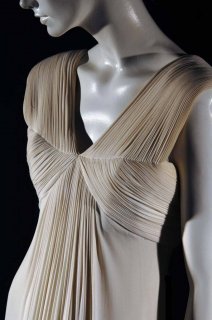Goddess in the Details
UNRAVELING THE MYSTERY OF MADAME GRÈS. BY HOLLY BRUBACH
This is the Year of the Goddess, judging by the clothes that designers sent down the runway.
So much for the sirens: they had their day, and now they’re tired; some are in rehab. More preferable, as archetypes go, is the goddess, with her ancient Grecian pedigree, her aloof demeanor suggesting self-possession and powers of divine intervention, her sensuous revelry in her own body. The goddess ratchets our standards considerably higher where sex is concerned: only gods need apply.
No wonder, then, that Madame Grès’s fluted and draped dresses are coming in for renewed appreciation and her life for unprecedented consideration, despite an ongoing perplexity when it comes to the facts, to say nothing of the bizarre circumstances surrounding her demise.
Patricia Mears’s ‘‘Madame Grès: Sphinx of Fashion’’ (Yale University Press) is a timely and welcome trove coinciding with an exhibition at the Museum at the Fashion Institute of Technology through April 19 . Mears brings to her subject a genuine appreciation for the engineering that formed the basis of Grès’s innovation and for her tenacious, obsessive pursuit of custom techniques that were inherently uncommercial, severely curtailing the expansion of her business empire. The celebrities who flocked to her maison de couture — Greta Garbo, Vivien Leigh, Dolores del Rio, Yvonne Printemps, Arletty, Sylvana Mangano — were her clients, not her friends. Her dresses were glamorous; her life was not, or so we’re told. Unlike Chanel, who lived at the Ritz, and Schiaparelli, who partied with the Surrealists, their evenings on the town enhancing their fashion reputations, Madame Grès went about dressmaking with the single-minded dedication of a nun in a turban. The one successful instance of licensing that she agreed to, for perfumes, made her a wealthy woman, however temporarily. Appropriately enough, she called her first and best-selling fragrance Cabochard, a colloquial term that Mears translates as ‘‘stubborn, obstinate, pig-headed.’’
Born Germaine Emilie Krebs in Paris in 1903, she called herself Alix and borrowed Barton as a surname from an employer; in 1937 she married Serge Czerefkov, a Russian painter who signed his work with an anagram of his first name: ‘‘Grès.’’ Alix Grès was born. About her childhood and her family, not much is known, and Mears is forced to rely on Grès’s own account, though there seems to be no reason to believe that a woman who changes her name three times would tell the truth about her background. Mears makes a conscientious attempt to disentangle the conflicting strands of Grès’s biography, with inconclusive results. The so-called sphinx of fashion remains a mystery.
More rewarding are Mears’s forays into parsing Grès’s career. She establishes the designer’s fascination with Grecian drapery not as an idiosyncratic pursuit but as a reflection of the broader revival of interest in classicism that was taking place at the time in sculpture (most famously, Aristide Maillol’s female nudes), in fashion photography (George Hoyningen-Huene’s images of women as statuary) and in theater (Giraudoux’s ‘‘La guerre de Troie n’aura pas lieu,’’ for which Grès designed the costumes). But also: in architecture (Auguste Perret’s Théâtre des Champs-Élysées) and in ballet (Stravinsky and Balanchine’s ‘‘Apollon Musagète’’) — though Mears, oddly, fails to avail herself of these last examples.
Regardless, it’s apparent that there was a protracted moment during the first decades of the last century when the culture was teetering, poised between two futures: one, revisiting the ancient verities, with the human figure front and center, as a means of stabilizing a society in the throes of convulsive change; the other, groping toward a new language to express and define an era that was still emerging. In retrospect, it looks as if those who championed the return to antiquity failed to rise above the inevitable likelihood that their work would look familiar and old-fashioned, not radical enough to give voice to a time of radical change. The new language turned out to be abstraction, and though many artists — Picasso, Stravinsky and Balanchine, the 20th century’s towering geniuses, among them — flirted with the classical revival, most moved on, with few exceptions.
Mears draws a parallel distinction in fashion, between designers choosing to work within the antique tradition of drapery as well as the use of uncut lengths of fabric, and others who chose instead to pursue the science of tailoring. ‘‘The dark woolen suit — the quintessential tailored garment — has remained ‘the’ modern fashion ensemble,’’ she writes, owing to ‘‘its sleek, understated silhouette, stripped of superfluous ornament.’’ It’s hard to avoid the conclusion that Grès, like a number of artists whose bent was innately conservative, simply bet on the wrong horse at the start of her career, and when history took a decisive turn for the abstract, she stubbornly, obstinately, pig-headedly went the other way.
As Mears presents it, Grès’s work falls neatly into three categories — ‘‘Ethnic Influences’’ and ‘‘Sculpting With Fabric,’’ in addition to classical drapery — and it soon becomes apparent in her account that they are all related: that the ethnic idioms provided Grès with solutions for problems in draping; that the draping took on a bolder, more fantastical dimension, freed from the obligation to depict the female body in literal terms, as she discovered the inherent properties of taffeta and brocades. Mears is at her best dissecting Grès’s ingenious methods of construction. Though I know how to sew (and therefore presumably come equipped with more technical understanding than some readers), I admit to wishing that Mears’s analyses fell alongside the photos of the dresses they discuss and that they were accompanied by diagrams. It’s a bit strenuous at times, figuring out which dress she’s referring to and then taking it apart in your mind, according to her description. But the exertion is well worth it, and the reader comes away with a more informed respect for Grès’s originality.
In an attempt to avoid distracting readers from Grès’s work, Mears saves the juiciest developments for last: Grès’s retirement to the south of France with her daughter, Anne, and grandson; her surreptitious transfer to a ‘‘low-rent’’ retirement home; her death in November 1993, and Anne’s mysterious cover-up. She continued to speak of her mother as if she were still alive and replied to reporters’ questions with invented quotes, until Laurence Benaïm, a journalist for Le Monde, grew suspicious, did some sleuthing and, in December 1994, turned up the death certificate.
The story is Benaïm’s to tell, and her 2003 book, ‘‘Grès’’ (Assouline), recapitulates it in detail, complete with her recollection of the wine bottle that Anne drops in her kitchen during questioning, the red puddle spreading on the floor at her feet. The author of a fine biography of Yves Saint Laurent, Benaïm is a stylish writer in French, but this translation does her no justice. The reader can only assume that sentences like ‘‘it was as a virtuoso of Parthenon draperies that this enemy of social events made her mark’’ sound better in the original. Still, despite the convoluted syntax, her text retains its poetry. And where Mears, with her subtitle, appears to have passed on the obligation to convey some sense of Grès as a person by declaring her impossible to know, Benaïm succeeds with a few deft strokes. She quotes Edmonde Charles-Roux, who called Grès ‘‘a dictator disguised as a mouse.’’ She writes of a woman ‘‘with her austere appearance and birdlike appetite’’ whose tastes ran to haute époque furniture, 17th-century Dutch paintings, Byzantine crosses, luxury cars and white roses. ‘‘Madame Grès was not afraid to go to the flea market with a torn raincoat, traveling by chauffeured Daimler,’’ Benaïm says. And while the fact that ‘‘she had the seats of her navy blue Jaguar covered with mink’’ may not constitute psychological insight, it’s a lot more revealing and personal than most of the rest of the information currently in the public domain.
Together, Mears’s and Benaïm’s accounts add up to something approaching a whole picture, and each fills in the various gaps left by the other. At times, they augment each other’s information. Mears tells us that Grès commissioned ‘‘Djersakasha,’’ a cashmere jersey woven as a tube so that she could use it without seams. Benaïm, that Grès took Helanca nylon, a material for bathing suits, and had it woven with Lurex, then deployed the result in an evening gown. Benaïm’s period illustrations and archival photographs (including two of Jacqueline Kennedy in a ravishing, asymmetrically draped gown at a White House reception) complement Mears’s more straightforward, even clinical, approach, in which the dresses are documented on mannequins. Throughout, what a magnificent, perverse and admirable character Grès turns out to be, deserving of our pity at the end of her life, never having asked for our affection.




















